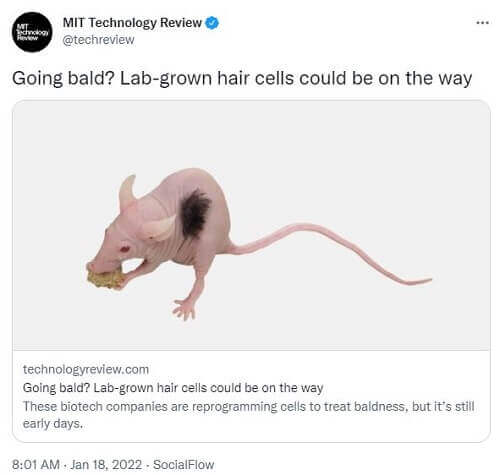A new biotech startup named dNovo is all over the news this week when it comes to the hair loss world. They have already grown reprogrammed human hair on mice.
Update: They raised $2.7 million in seed funding.

I am no longer keen to cover startup hair loss cure related companies that have yet to even commence pre-clinical trials. In all past such cases, we have always been left with major disappointment. Such companies waste years of our time before ending up in situations such as the below:
- Fail or see minimal results during Phase 2 or Phase 3 clinical trials (e.g., Follicum) despite significant hopes after Phase 1. Then they discontinue further product development. In the case of Histogen and Samumed (Biosplice), 10 plus years of false hopes culminating in the end of their hair loss operations.
- Cannot raise sufficient funds at some point very late in the process. (e.g., Riken/Tsuji and Intercytex/Aderans).
- Close down their hair loss program abruptly with no clear explanation (e.g., Aclaris). In many cases, despite decent hair growth results.
- Keep announcing minor new developments even ten plus years after inception, with no end in sight. e.g., Follica just released a poster.
- Get involved in licensing and other partnership disputes (e.g., Shiseido/Replicel).
I increasingly feel that most new companies are all money-making schemes to raise investor funds or boost share prices. But the hope for someone legitimate never ends (at least not till I finally shave my head).
dNovo: Hair Growth with Stem Cells
However, for the past three days, dNovo has been in the news every day and several readers commented and e-mailed about the company. “De novo” stands for “anew” or “from the beginning”. i.e., brand new hair follicle formation in this case. Note that there is another company named “denovo hair” (but their site suggests it is no longer in business).
The initial detailed article on dNovo was published in MIT Technology Review. Then came Fortune. Followed by BoingBoing. Today, I finally gave in after Slashdot also got in on the game. The comments underneath their article are funny.
I am covering dNovo despite major reservations. Assuming they even succeed in humans, I do not think that dNovo’s hair cell regeneration product can come to market before 2030. And Stemson will likely beat them to the game.
dNovo Cell Reprogramming Process
dNovos’s lab-grown hair process is outlined on their site in five steps:
- Collect human hair cells at their facility. Per several articles, they might even use skin cells and convert them to hair cells.
- Add proprietary reprogramming factors.
- General hair producing cells.
- Seed these cells into the balding recipient’s scalp.
- See visible hair growth in 1-3 months post implantation.
As of second quarter 2021, dNovo had successfully developed the reprogramming system to generate human dermal papilla cells (patent pending). These reprogrammed dermal papilla cells perform biochemically as expected of human dermal papilla cells.
At the end of 2020, the company successfully transplanted reprogrammed human hair stem cells onto mice. These then turned into actual human hair (image at the top of this post).
Dr. Ernesto Lujan
dNovo was founded in 2018 by Stanford University educated biologist Dr. Ernesto Lujan. He has a PhD in genetics, and has many other accomplishments per his bio on YCombinator. dNovo’s team consist of PhDs and MDs trained at Stanford, Harvard, and Caltech.
Dr. Lujan was a co-author of a 2012 paper in which his team converted mouse skin cells into cells that become the three main parts of the nervous system. So it seems like he has been interested in this type of cell reprogramming work for at least ten years.
I love this quote on YCombinator:
“After hair, we envision using our cellular reprogramming technique to make any cell, any tissue or any organ on demand to replace what is lost as we age.”
Per Dr. Lujan (in Fortune magazine):
“We are currently in the preclinical stage of development. We have shown the results in laboratory mice and are very excited with those. We hope to eventually demonstrate the efficacy in human trials and make our product commercially available, but at the moment we are in the early stages of the whole process.”